Abstract
This research introduces the Iterative Overlap Optimization Placement (IOOP) method, a novel approach designed to enhance the efficiency of irregular pattern packing by dynamically optimizing overlap ratios and pattern placements. Utilizing a modified genetic algorithm, IOOP addresses the complexities of arranging irregular patterns in a given space, focusing on improving spatial and material efficiency. This study demonstrates the method’s superiority over the traditional Size-First Non-Iterative Overlap Optimization Placement technique through comparative analysis, highlighting significant improvements in spatial utilization, flexibility, and material conservation. The effectiveness of IOOP is further validated by its robustness in handling diverse pattern groups and its adaptability in adjusting pattern placements iteratively. This research not only showcases the potential of IOOP in manufacturing and design processes requiring precise spatial planning but also opens avenues for its application across various industries, underscoring the need for further exploration into advanced technological integrations for tackling complex spatial optimization challenges.
Keywords:
irregular packing; modified genetic algorithm; overlap detection; spatial efficiency; iterative optimization MSC:
68U05; 90C27
1. Introduction
The study of irregular packing problems holds a pivotal role in the optimization of space and material utilization across various industries, including manufacturing, logistics, and design [1]. This domain focuses on the efficient arrangement of irregularly shaped objects within a confined space to minimize waste and enhance productivity [2]. The complexity of these problems, stemming from the non-uniformity of object shapes and the constraints of the packing environment, necessitates sophisticated solutions that can adapt to a wide range of scenarios [3]. Various industries utilize these algorithms to enhance their operational efficiency and resource management. Figure 1 demonstrates the diverse applications of irregular packing algorithms across different sectors, showcasing the practical significance and versatility of these methodologies.

Figure 1.
Applications of irregular packing algorithms in various industries: (a) laser cutting stainless steel, (b) waterjet cutting metal plates, (c) CNC milling aluminum alloy parts.
Historically, research in this area has progressed through the development of various algorithms, each aiming to tackle specific facets of the packing dilemma. Early approaches often relied on heuristic methods, providing practical solutions with satisfactory outcomes for specific instances. However, these methodologies frequently fell short in terms of generality and efficiency, particularly when dealing with complex shapes or when seeking to maximize the optimization of space.
Amid this backdrop, Martinez-Sykora et al. [4] broke new ground with algorithms allowing for free orientation of pieces in 2DIBPP, a previously underexplored avenue. Concurrently, the works of M.O. Rodrigues and Toledo [5] on the irregular strip packing problem and Elkeran [6] on sheet nesting highlighted the economic and practical significance of optimizing cutting processes, further enriching the field with novel mixed-integer programming (MIP) models and hybrid algorithms. Pantoja-Benavides et al. [7] developed the Normalized Direct Trigonometry Model (NDTM) to optimize the placement of irregular shapes on strips, enhancing efficiency by incorporating separation constraints. Yang et al. [8] improved the resolution of 2D irregular cutting and packing problems with a fidelity-adaptive evolutionary optimization algorithm that dynamically adjusts nesting strategies. Bartmeyer et al. [9] created an expert system using reinforcement learning to adjust cutting plans based on detected material defects, which optimizes layouts to minimize waste and boost production efficiency. Qi et al. [10] proposed a model utilizing an improved marine predator algorithm to enhance the nesting of various shapes on coil materials, thereby reducing costs and increasing material utilization in sectors like automotive and electronics.
Cherri et al. [11] introduced innovative MIP models for the irregular strip packing problem, addressing complex geometries and rotations, while Alvarez-Valdes et al. [12] and Abeysooriya et al. [13] explored the dimensions of nesting and bin packing, respectively, each contributing new formulations and heuristic methods to enhance packing efficiency. The exploration extended into genetic algorithms by Mundim et al. [14], showcasing a novel approach for complex nesting problems, and the integration of novel data structures for improved computational efficiency in the studies by Cherri et al. [15].
Despite advances in the field of two-dimensional irregular cutting and packing through advanced algorithms and machine learning techniques, significant gaps remain. These include the lack of real-time adaptation to operational changes, the need for comprehensive optimization strategies that consider a wider array of variables, and the challenge of developing scalable and versatile models suitable for diverse industries. Our research introduces an innovative approach that targets these gaps by developing a robust and flexible algorithm capable of real-time responses and comprehensive, balanced optimization suitable for various industrial applications.
The introduction of the Iterative Overlap Optimization Placement (IOOP) method represents the culmination of these endeavors, offering a dynamic and sophisticated solution capable of navigating the multifaceted challenges presented by irregular packing problems. Building upon the limitations and insights from previous studies, IOOP employs a modified genetic algorithm, iteratively optimizing overlap ratios and pattern placements, thereby showcasing unparalleled flexibility and robustness.
The diversity of approaches and methodologies from studies such as Peralta et al. [16] with their non-linear mathematical models, the sparsest packing considerations by Romanova et al. [17], and the specialized branch-and-bound method introduced by Wang et al. [18], reflect the field’s dynamic nature. Contributions like the general heuristic for solving nesting problems by Mundim et al. [19], the random-key genetic algorithm by Pinheiro et al. [20], and the novel algorithm for fabric packing by Hu et al. [21] each mark significant strides toward operational efficiency and material conservation.
As we venture further, exploring solutions like the phi-functions for ellipse packing by Stoyan et al. [22], the quadratically constrained programming model by Cherri et al. [23], and the novel genetic algorithm approach by Bortfeldt [24], we acknowledge the breadth of innovation that frames the current landscape of packing problem research. This is complemented by advances in guillotine cutting and packing formulations by C.D. Rodrigues et al. [25] and the pioneering Floating-Cuts model by Silva et al. [26], each adding depth and versatility to the array of available solutions.
These methods offered a more systematic approach to exploring the solution space, allowing for the identification of more optimized arrangements through simulation and iteration. Despite these improvements, a gap remained in dynamically adjusting to the multifaceted nature of packing irregular shapes, where the interplay of spatial orientation, shape compatibility, and optimization objectives requires a nuanced understanding and flexible adjustment.
Building on these insights, our research introduces the Iterative Overlap Optimization Placement (IOOP) method, an innovative approach that significantly advances the state of the art in irregular packing solutions. Unlike its predecessors, IOOP employs a modified genetic algorithm that not only considers the spatial arrangement of irregular shapes but also dynamically optimizes the overlap ratios and placements through an iterative process. This method allows for a more refined adjustment to packing configurations, tailoring solutions to the unique constraints and opportunities of each scenario.
The necessity and significance of our research are underscored by its ability to address previous shortcomings through a novel optimization framework that enhances both spatial and material efficiency. The IOOP method demonstrates superior flexibility and robustness compared with traditional Size-First Non-Iterative Overlap Optimization Placement techniques, showcasing its potential in a broad array of applications that require meticulous spatial planning and optimization.
Furthermore, our work paves the way for further exploration into integrating advanced technologies with irregular packing algorithms, aiming to solve even more complex spatial optimization challenges. The advancements presented in our research not only contribute to the academic understanding of irregular packing problems but also have practical implications for industries seeking to optimize their packing and layout processes.
In summary, the study of irregular packing problems remains a vital and challenging domain within optimization research. Our contribution, the IOOP method, represents a significant leap forward, offering a more adaptable, efficient, and robust solution to these complex problems. By addressing the limitations of previous research and presenting a novel approach, we underscore the ongoing need for innovation in this field, highlighting the potential for future advancements and applications.
2. Image Preprocessing
Before delving into the specifics of image processing techniques applied in our study, it is crucial to establish the context and the challenges addressed by these methods. The need for advanced image processing arises from the complexities associated with the accurate detection and placement of irregular patterns. These challenges are rooted in the inherent variability of pattern shapes and sizes, which traditional packing methods often fail to accommodate efficiently.
To address these challenges, our approach utilizes sophisticated image processing algorithms to enhance the accuracy and efficiency of pattern recognition and placement. This section outlines the methodologies employed, beginning with the extraction and binarization of images from CAD files, which sets the foundation for the subsequent optimization processes.
2.1. Resizing of the Image
The images of visual patterns were retrieved from DWG files generated using AutoCAD software, which utilizes the C++ programming language. Following extraction, these images underwent a binarization process [27]. This technique effectively distinguished between the color contrasts of the design elements and their background, as illustrated in Figure 2a.
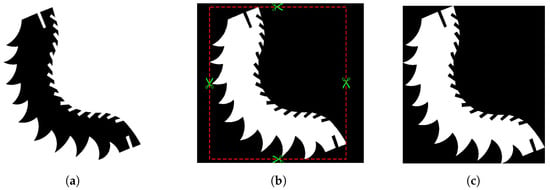
Figure 2.
The process of preparing the pattern image for resizing: (a) binarization of the original image, (b) demonstration of pattern image cropping, (c) the extracted pattern image.
Frequently, the measurements shown in the illustration fail to precisely reflect the object’s true dimensions. Therefore, proportionally resizing the illustration is essential. The process began with trimming the image’s edges, as shown in Figure 2b,c. Afterward, the image was adjusted in size to match the actual dimensions of the workpiece accurately. After adjusting the image size to accurately match the part’s real dimensions, it is then overlaid onto another image that has a black background.
2.2. Expansion of the Pattern Image
In the process of arranging component placements, recognizing the gap between them is critical, as this space is necessary for the removal of material during the cutting phase. To address this concern, the dimensions of the component figures are systematically increased following Equation (1), where i and j represent the row and column indices of the components, respectively. This indexing helps in specifying the precise location of each component on the material layout. In this context, g represents the gap distance between separate parts.
The accuracy specified in this context is 0.5 mm, with each pixel corresponding to this unit of measurement. Additionally, a gap of 4 mm is established between the components. The process of expanding the image is illustrated in Figure 3.
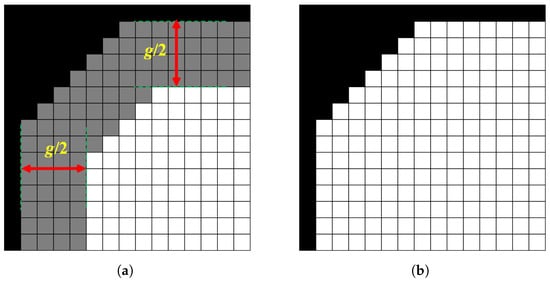
Figure 3.
Schematic representation of image expansion: (a) identification of expansion area and (b) visualization of the expanded image.
In Figure 3a, white pixels represent the pattern, while gray pixels indicate areas designated for expansion, and black pixels denote the background. When the criteria outlined in Equation (1) are satisfied, the gray pixels are converted to white, signifying their inclusion in the expanded pattern. The image, after undergoing expansion, is displayed in Figure 3b.
The enhanced version of the initial pattern, as shown in Figure 4a, features the expanded region distinctly highlighted in red to enhance its visibility. The foundational principle behind the placement optimization of a pattern hinges on the overlap ratio of its expanded area, which includes overlaps with both other patterns and the expanded area of the board. This concept is delved into more comprehensively in the following sections of the document. As a result, an additional expansion of the pattern, building upon the first expansion, is required. The width of the expanded area for this subsequent expansion is determined as outlined below:
where and denote the dimensions of the pattern’s length and width, respectively. As the pattern’s size decreases, the width of the expanded area, , reduces correspondingly. The minimum value for is established at 15, which can be expressed as follows:
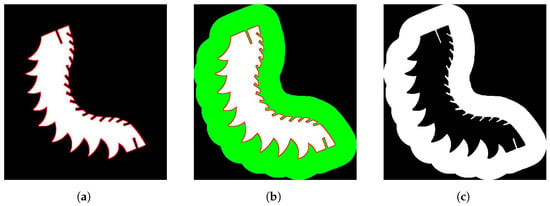
Figure 4.
Sequential expansion outcomes: (a) outcome of the initial expansion, (b) outcome of the subsequent expansion, (c) the area subsequently expanded.
This modification ensures that the pattern retains an adequate area for the optimization process, facilitating effective spatial arrangement and utilization.
The first phase of expanding the pattern, illustrated in Figure 4a, displays the expanded region highlighted in red. The next phase of expansion is presented in Figure 4b, where the expanded area is clearly delineated in green. This indicates the portion of the pattern expanded specifically during the second phase, designated for enhancing the efficiency of the packing process, as shown in Figure 4c.
The board image, as shown in Figure 5a, undergoes expansion using the same width value derived from the pattern dimensions, as illustrated in Figure 5b. In this depiction, the black area represents the board, and the green area indicates the expanded region. While this expanded region isn’t physically present, it serves exclusively for the optimization of pattern placement. Due to the variation in the width of the expanded area among different patterns, the expansion of the board image should be carried out at the beginning of the packing process for each pattern, considering the unique expanded area related to each.
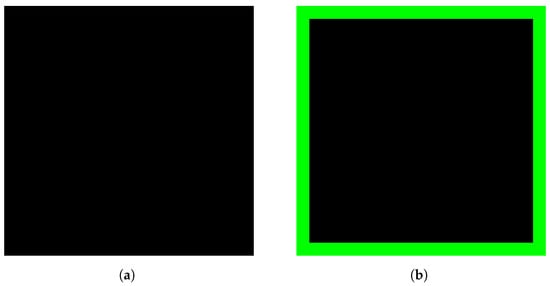
Figure 5.
Comparative analysis of board image pre- and post-expansion: (a) the board image prior to expansion and (b) the board image featuring the expanded area.
A successful approach to pattern arrangement involves organizing them in a sequence starting with larger patterns and then proceeding to smaller ones. This method promotes an orderly layout that maximizes space efficiency. Within this context, and represent the horizontal and vertical dimensions, respectively, as demonstrated in Figure 6.
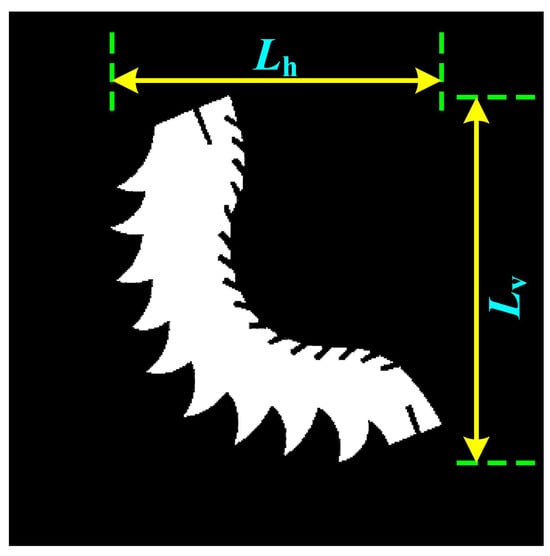
Figure 6.
Schematic representation of pattern size.
All patterns designated for packing are sorted based on their size, Lt, which is defined in the following manner:
3. Mathematical Model and Its Optimization
3.1. Modified Genetic Algorithm
3.1.1. Encoding
The genetic algorithm (GA) serves as a search technique that emulates natural selection and genetic processes to find solutions for optimization challenges [28]. It starts with a set of random solutions and methodically employs selection, crossover, and mutation principles to evolve new sets of solutions, striving to identify the optimal solution over multiple iterations [29]. In this research, a refined version of the genetic algorithm is utilized to determine the best spatial configuration of patterns. The positioning traits of these patterns within the image are defined by three parameters: the x-coordinate, the y-coordinate, and the angle of rotation. These data are initially encoded in a binary system.
In each case, the binary encoding comprises 27 bits in total. The first 12 bits are dedicated to representing the x-coordinate of the pattern, followed by bits 13 to 15, which specify the pattern’s rotational angle. Subsequently, bits 16 to 27 are used to denote the y-coordinate of the component. This encoding procedure, utilized across a sample size of 500, is visually depicted in Figure 7.
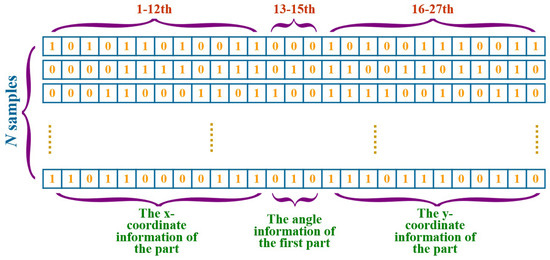
Figure 7.
Representation of binary code in genetic algorithms.
3.1.2. Mutation
In the mutation aspect of the adapted genetic algorithm described in this research, specific binary digits are randomly switched, flipping from 0 to 1 or the reverse [30]. However, determining the exact number of bits to alter presents a challenge. To address this issue, a parameter named is introduced. The code for a given sample is labeled as SC, with indicating the number of 1s in code , and denoting the number of 0s. Referring to Figure 7, we can derive the following insights:
The value of is randomly selected to be either or as illustrated below:
The quantity of bits selected for alteration is represented by Nr, which has as its highest allowable value. The exact value of is chosen to lie within the spectrum from 0 to , and this relationship can be described as follows:
Additionally, a random variable, labeled as r, is utilized to identify the precise bit to be modified during the mutation phase. The value of r is set to fall within the interval from 1 to 27, and this can be expressed in the following manner:
3.1.3. Decoding
The values allocated to the x-coordinate and y-coordinate of the pattern must comply with designated boundaries set within a predetermined range. This requirement is outlined as follows:
where and represent the dimensions of the search area along the X-axis and Y-axis, respectively. Moreover, and denote the dimensions of the component along the X-axis and Y-axis, respectively, as illustrated in Figure 8.
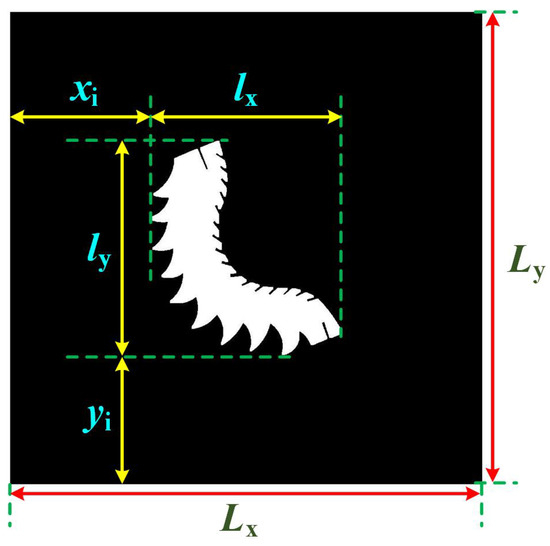
Figure 8.
Schematic representation of the pattern dimensions and position.
Considering a 12-bit binary number can represent = 4096 distinct combinations of information, the spatial attributes of the pattern are defined by the 27-bit binary sequence in the following manner:
In this context, BIN refers to the allocation of a 27-bit binary code for each sample, succinctly capturing the digital attributes associated with each.
3.2. Iterative Overlap Optimization Placement (IOOP)
Figure 9 showcases an intricately designed flowchart detailing the key steps of the search approach used in this research. The procedure begins by arranging patterns according to their dimensions, as shown in Figure 8. Following this, the initial N patterns are chosen based on a set value, , and specific size guidelines outlined in Equation (18). Through the adoption of a revised genetic algorithm outlined in this paper, the placement of each pattern is refined. An evaluative comparison is then made among these N patterns, selecting the one with the most substantial overlap ratio for inclusion in this batch. The later parts of this document delve into every step presented in the flowchart in detail, providing a comprehensive exploration of the algorithmic tactics implemented for optimization.
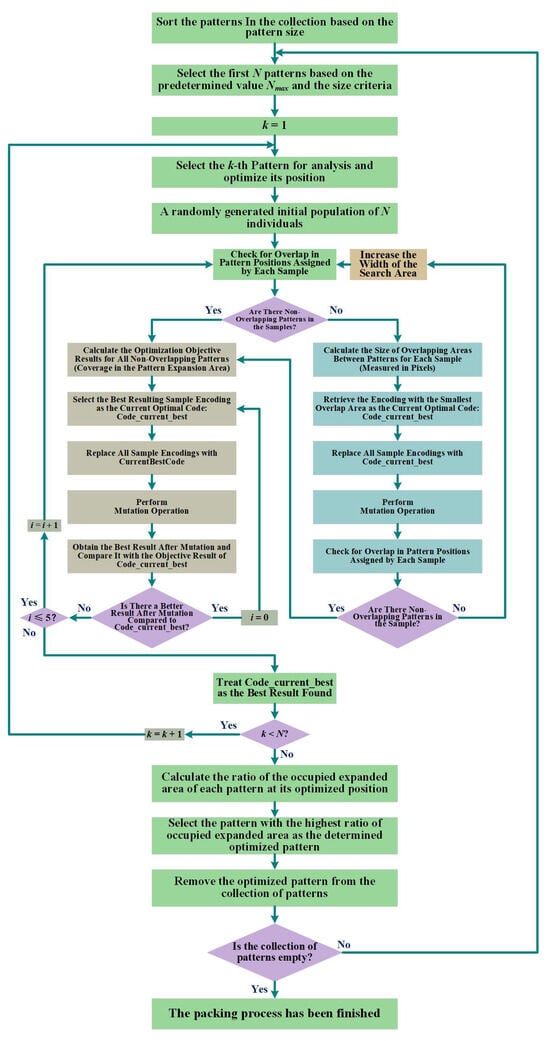
Figure 9.
Flowchart depicting the theoretical framework for pattern packing.
3.2.1. Overlap Detection
Avoiding overlap among patterns is crucial. In this regard, we propose a straightforward and highly effective technique that utilizes the aggregate number of white pixels within the image as a mechanism to identify potential overlaps. Equation (13) establishes the corresponding condition that needs to be met:
Here, is the cumulative count of white pixels in the merged image IMG, with and reflecting the numbers of white pixels in images and , respectively. The calculation of these values is described as follows:
Through the comparison of white pixel counts, overlaps between patterns can be identified. If Equation (13) is not met, it signifies overlapping between the patterns. Therefore, patterns that intersect in this manner are deemed incompatible and should be excluded from consideration. The patterns are represented by white pixels, and the image’s background pixels are coded as black. The combined image, denoted as IMG, is defined by the equation provided:
The entire process is visually represented in Figure 10. Importantly, Figure 10c showcases the unified pattern that emerges from the combination of the patterns shown in Figure 10a,b.
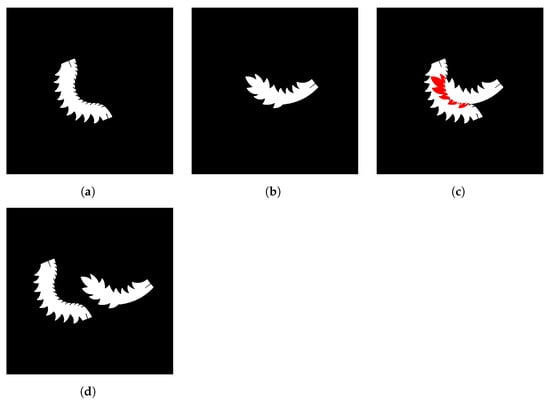
Figure 10.
Comparative analysis of pattern packing, with and without overlap: (a) pattern 1, (b) pattern 2, (c) packing with overlap, (d) packing without overlap.
3.2.2. Overlap Optimization
For the placement of the patterns, it is initially crucial to ensure that the entire pattern is contained within the boundaries of the board. This requirement is confirmed by Equations (10)–(12), which verify that any values obtained for the x-coordinate (), y-coordinate (), and rotation angle of the pattern adhere to this limitation. Secondly, as previously emphasized, avoiding overlap between patterns is essential. The theory guiding the optimization of the pattern’s position is centered on the overlapping ratio of the pattern’s expanded area. This expanded area is illustrated by the green area shown in Figure 4b.
A random placement of one pattern on the board image is depicted in Figure 11a, which aligns with the position of the expanded area as shown in Figure 11b. The overlapping area between the pattern’s expanded area and the board’s expanded area (the green area along the edges of the board image) is highlighted in red, as illustrated in Figure 11c. It is clear that this position is not optimized. Utilizing the modified genetic algorithm described earlier, after failing to discover a superior result in five consecutive attempts, the position at this stage is considered the optimal placement. In the optimization process implemented in our study, the term “optimal” refers to the best solution found under the algorithm’s specific operational parameters. Our algorithm terminates when no improvement is observed after five consecutive iterations, which we define as reaching an “optimal” state. This approach balances computational efficiency with the thoroughness of the search within the feasible solution space, recognizing that the solutions obtained are optimal in the context of the specified algorithmic constraints rather than in a global sense. The final optimized position of the pattern’s expanded area is demonstrated in Figure 11d, which correlates to the position of the pattern, as shown in Figure 11e, thereby maximizing the ratio of the overlapping area.
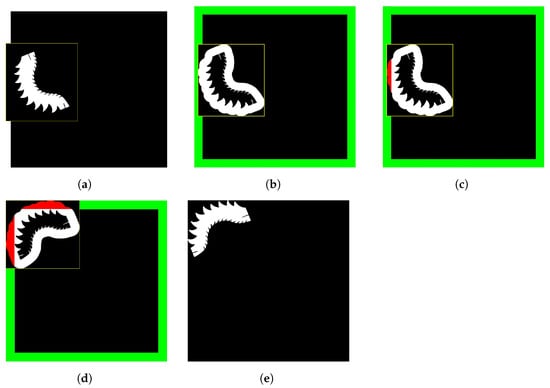
Figure 11.
Process and optimization of pattern placement with emphasis on overlapped areas: (a) initial random position of the pattern, (b) corresponding position of the expanded area, (c) the overlapped area of the expanded area of the pattern, (d) optimized position of the expanded area, (e) optimized position of the pattern.
3.2.3. The Packing of the First Pattern
The sequence of packing the patterns hinges on two critical factors: the size of the pattern and the overlapping ratio of the pattern’s expanded area. Initially, the sequence of the patterns is determined solely based on the patterns’ size. However, it is possible that the overlapping ratio of the first pattern may not be the highest. To address this discrepancy, the first (here it was set as 10) patterns in the sequence are selected, and any pattern that is smaller than (here it was set as 0.75) times the size of the first pattern is excluded from this sequence. The corresponding equation can be formulated as follows:
According to Equation (18), ultimately, only the first four patterns were selected. The positions of these selected patterns were optimized utilizing the modified genetic algorithm, as illustrated in Figure 12a–d. Among these, the expanded area of the third pattern was identified to have the highest overlapping area ratio, as depicted in Figure 12c. This corresponds to the position of the pattern shown in Figure 12e, and it is determined to be the first pattern packed on the board.
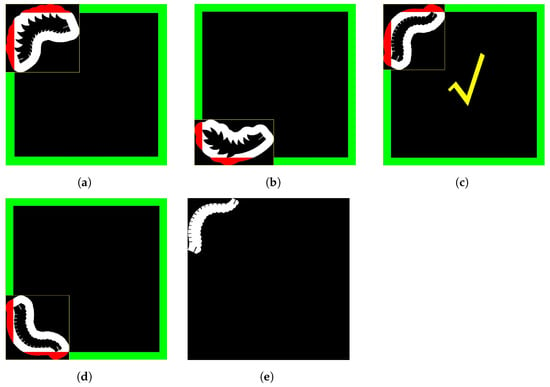
Figure 12.
Sequential optimization and placement of patterns in the first group: (a) optimized position of the first pattern, (b) optimized position of the second pattern, (c) optimized position of the third pattern, (d) optimized position of the fourth pattern, (e) packed first pattern on the board.
3.2.4. The Packing of the Subsequent Patterns
Up to this point, only the packing of the first pattern has been completed. The pattern that has already been packed on the board will be removed from the sequence of patterns. Employing the same selection criteria, another set of patterns is selected; from this set, three patterns are ultimately identified for further evaluation and potential packing.
Prior to the placement of the initial pattern, the board image remains unoccupied, with the pattern’s expanded area exclusively reserved for possible overlaps with the board’s expanded area. However, for the patterns positioned subsequently, their expanded regions are capable of overlapping not only with the board’s expanded area but also with the patterns already positioned on the board. Areas of overlap are highlighted in red, as depicted in Figure 13a–c.
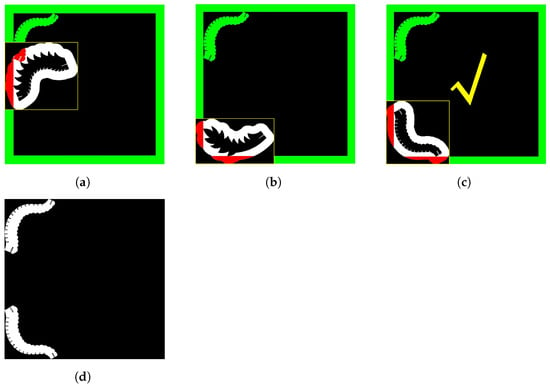
Figure 13.
Sequential optimization and placement of patterns in the second group: (a) optimized position of the first pattern, (b) optimized position of the second pattern, (c) optimized position of the third pattern, (d) packing of the first two patterns on the board.
Ultimately, the pattern’s expanded area depicted in Figure 13c was identified to have the highest overlap ratio. This corresponds to the position of the pattern as shown in Figure 13d, thereby completing the packing of the second pattern. Employing the same methodology, the process of packing the third pattern is illustrated in Figure 14, with the final outcome of packing the first three patterns presented in Figure 14c.
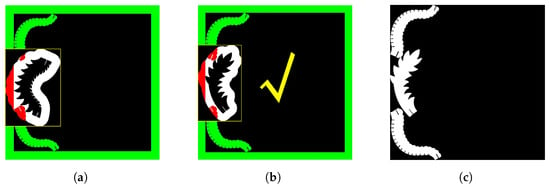
Figure 14.
Sequential optimization and placement of patterns in the third group: (a) optimized position of the first pattern, (b) optimized position of the second pattern, (c) packing of the first three patterns on the board.
3.2.5. Left-to-Right Pattern Placement Strategy
The approach for arranging patterns adopts a systematic progression from left to right, starting from the segment already in use, as depicted in Figure 15a. The area currently occupied is delineated to the left of the red dashed line. In positioning the third pattern, the focus is on fitting it within these predefined boundaries to avoid increasing the width already utilized. Figure 15b illustrates the permissible leftmost placement of the pattern in yellow, whereas the rightmost boundary is marked by a pattern in aqua. This technique ensures the third pattern fits within the designated limit, thereby efficiently utilizing space without expanding the occupied area. Derived from Figure 15b, the formula to calculate the search area’s width for the third pattern is as follows:
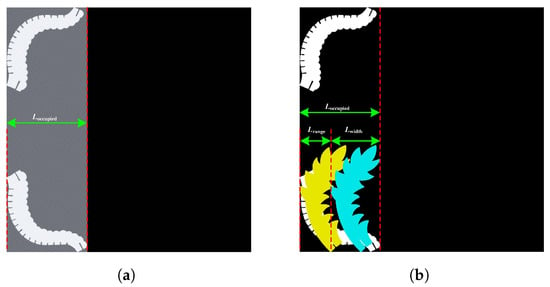
Figure 15.
A schematic illustration of the placement range for the third pattern without increasing the occupied width: (a) width occupied by the first two patterns and (b) allowable positioning range for the third pattern.
The x-coordinate for positioning the third pattern is determined by the following equation:
It is generally feasible to locate a fitting position for the third pattern within the defined width of , as depicted in Figure 15a. However, finding an optimal placement that avoids encroaching on the areas taken by earlier positioned patterns can present difficulties, as shown in Figure 16. The constraints of might make it tough to find an ideal spot for the current pattern, leading to potential overlaps with previously arranged patterns within the framework of the adjusted genetic algorithm. This challenge does not imply that it is impossible to place the pattern suitably; opportunities for appropriate placement may still arise.
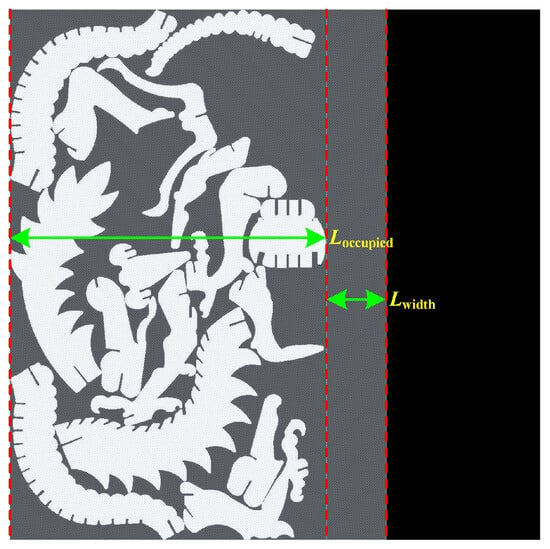
Figure 16.
Schematic depiction of search area width expansion.
To overcome this obstacle, the area of overlap for all samples is determined, and the position with the least overlap is deemed most suitable for placing the pattern. Consequently, the codes for all samples are updated to reflect the code of the sample with the smallest overlap. Following this, a mutation operation is applied to the codes. Should a pattern be identified that does not overlap with any others, the optimization sequence outlined in Figure 9 is set in motion. Nonetheless, there may be instances when securing an appropriate spot for the pattern remains challenging. Under such circumstances, the search area’s width designated for the current pattern is expanded by , which corresponds to the pattern’s width, as indicated in Figure 16. The iterative optimization process that handles this adjustment is detailed in Algorithm 1.
With the expansion of the occupied width, it is vital to increase the sample size within the genetic algorithm to improve the chances of finding an optimal position for the pattern. This research calculates the number of samples required based on the given formula:
where the symbols ‘’ represent the ceiling function, used to round a number up to the nearest integer.
| Algorithm 1 Iterative Overlap Optimization Placement Algorithm Pseudocode |
|
3.2.6. Layout Optimization Pseudocode
The pseudocode that outlines the principles of layout optimization is delineated as follows.
4. Packing Results
To highlight the superiority of the Iterative Overlap Optimization Placement (IOOP) method proposed in this study, Figure 17 presents a comparative analysis between IOOP and the Non-Iterative Overlap Optimization Placement method. This comparison is aimed at demonstrating the enhanced efficiency and spatial utilization achieved through IOOP’s dynamic iterative process versus the static approach of size-based pattern ordering.
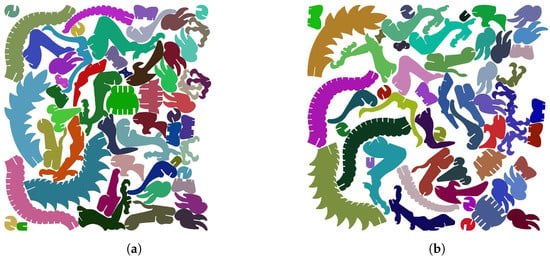
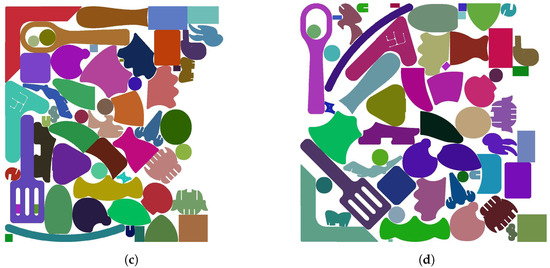
Figure 17.
Comparative analysis of iterative vs. non-iterative overlap optimization for pattern placement: (a) Iterative Overlap Optimization Placement results for the first pattern group, (b) Non-Iterative Overlap Optimization Placement results for the first pattern group, (c) Iterative Overlap Optimization Placement results for the second pattern group, (d) Non-Iterative Overlap Optimization Placement results for the second pattern group.
Following Figure 17, our comparative analysis emphasizes the effectiveness of the Iterative Overlap Optimization Placement (IOOP) method over the Non-Iterative Overlap Optimization Placement. The strategic differences, especially in pattern ordering and iterative optimization, are crucial to their performance outcomes.
Strategic Approach Variance: IOOP significantly enhances material utilization by dynamically adjusting pattern placement based on iterative optimization outcomes. This adaptability is in stark contrast to the non-iterative method, which, despite its iterative nature for overlap reduction, maintains a static order based on initial size rankings.
Comparative Outcomes: (1) First Pattern Group Analysis: The dynamic ordering of IOOP leads to more compact and efficient layouts, demonstrating superior spatial utilization. As shown in Figure 17, IOOP outshines its counterpart by effectively minimizing gaps and overlaps between patterns, thus achieving higher material efficiency; (2) Second Pattern Group Insights: Applying IOOP to a second set of patterns further underscores its adaptability and robustness. While both methods strive to optimize overlap ratios, IOOP’s flexible ordering strategy results in better material utilization and more aesthetically pleasing layouts.
Material and Spatial Efficiency: Through iterative adjustments in pattern placement for optimal overlaps, IOOP markedly improves spatial management and material conservation. This method results in not only higher efficiency in terms of material usage but also in more visually appealing arrangements, unlike the static, non-iterative approach.
Conclusive Advantages: The Iterative Overlap Optimization Placement method distinguishes itself with dynamic optimization capabilities, leading to significant enhancements in material utilization and layout compactness. Its proven adaptability and effectiveness across different pattern sets underscore IOOP’s potential for widespread application, particularly in sectors requiring precise spatial planning. These encouraging outcomes suggest further investigation into IOOP’s application breadth, with a focus on boosting material efficiency in manufacturing and design processes.
5. Conclusions
This study has introduced and rigorously evaluated the Iterative Overlap Optimization Placement (IOOP) method, aimed at enhancing pattern packing efficiency through dynamic optimization of overlap ratios and pattern placement. By comparing the IOOP method with the Size-First Non-Iterative Overlap Optimization Placement approach, we have demonstrated the former’s superiority in various key aspects of pattern placement optimization. Here are the core conclusions drawn from our analysis:
- 1.
- Enhanced Spatial and Material Efficiency: The Iterative Overlap Optimization Placement (IOOP) method significantly outperforms the non-iterative approach in terms of spatial utilization and material efficiency. It optimizes the use of available space and materials by dynamically adjusting the placement of patterns, thus minimizing waste.
- 2.
- Flexibility and Robustness: Demonstrated across various pattern groups, IOOP’s dynamic pattern ordering showcases superior flexibility and robustness. This adaptability leads to more efficient layouts and visually appealing arrangements, evidencing the method’s capability to handle diverse and complex patterns effectively.
- 3.
- Broad Application Potential: IOOP’s proven effectiveness suggests a wide applicability in sectors requiring detailed spatial planning and optimization. Its ability to enhance material utilization while maintaining high-quality layouts positions it as a valuable tool in manufacturing, design, and beyond.
- 4.
- Future Research and Applications: Encouraging outcomes from the use of IOOP point towards the need for further exploration into its application across different industries. Future research could aim to refine the method, exploring the integration with advanced technologies to tackle even more complex spatial optimization challenges.
Author Contributions
Conceptualization, L.M. and A.M.K.; methodology, L.M.; software, R.T.M.; formal analysis, L.D. and M.A.; investigation, L.M.; resources, L.M. and R.T.M.; data curation, L.M.; writing—original draft preparation, L.M.; writing—review and editing, L.D. and M.A.; visualization, L.M.; supervision, A.M.K.; project administration, A.M.K.; funding acquisition, M.A. All authors have read and agreed to the published version of the manuscript.
Funding
This work was supported by the Researchers Supporting Project (Grant No. RSP2024R274) from King Saud University, Riyadh, Saudi Arabia.
Data Availability Statement
Data is contained within the article.
Acknowledgments
This work was supported by the Researchers Supporting Project (Grant No. RSP2024R274) from King Saud University, Riyadh, Saudi Arabia. The computational resources generously provided by the High-Performance Computing Center of Nanjing Tech University are greatly appreciated.
Conflicts of Interest
Author Liang Ding was employed by the company Nanjing WIT Science & Technology Co., Ltd. The remaining authors declare that the research was conducted in the absence of any commercial or financial relationships that could be construed as a potential conflict of interest.
References
- Guo, B.; Zhang, Y.; Hu, J.; Li, J.; Wu, F.; Peng, Q.; Zhang, Q. Two-dimensional irregular packing problems: A review. Front. Mech. Eng. 2022, 8, 966691. [Google Scholar] [CrossRef]
- Martins, T.C.D.; Tsuzuki, M.S. Rotational placement of irregular polygons over containers with fixed dimensions using simulated annealing and no-fit polygons. J. Braz. Soc. Mech. Sci. Eng. 2008, 30, 205–212. [Google Scholar] [CrossRef]
- Gomes, A.M. Irregular packing problems: Industrial applications and new directions using computational geometry. IFAC Proc. Vol. 2013, 46, 378–383. [Google Scholar] [CrossRef]
- Martinez-Sykora, A.; Alvarez-Valdes, R.; Bennell, J.A.; Ruiz, R.; Tamarit, J.M. Matheuristics for the irregular bin packing problem with free rotations. Eur. J. Oper. Res. 2017, 258, 440–455. [Google Scholar] [CrossRef]
- Rodrigues, M.O.; Toledo, F.M. A clique covering MIP model for the irregular strip packing problem. Comput. Oper. Res. 2017, 87, 221–234. [Google Scholar] [CrossRef]
- Elkeran, A. A new approach for sheet nesting problem using guided cuckoo search and pairwise clustering. Eur. J. Oper. Res. 2013, 231, 757–769. [Google Scholar] [CrossRef]
- Pantoja-Benavides, G.; Álvarez Martínez, D.; Torres, F.P. The Normalized Direct Trigonometry Model for the Two-Dimensional Irregular Strip Packing Problem. Mathematics 2024, 12, 2414. [Google Scholar] [CrossRef]
- Yang, Y.; Liu, B.; Li, X.; Jia, Q.; Duan, W.; Wang, G. Fidelity-adaptive evolutionary optimization algorithm for 2D irregular cutting and packing problem. J. Intell. Manuf. 2024. [Google Scholar] [CrossRef]
- Bartmeyer, P.M.; Oliveira, L.T.; Leão, A.A.S.; Toledo, F.M.B. An expert system to react to defective areas in nesting problems. Expert Syst. Appl. 2022, 209, 118207. [Google Scholar] [CrossRef]
- Qi, D.; Yang, W.; Ding, L.; Wu, Y.; Tian, C.; Yuan, L.; Wang, Y.; Huang, Z. An Intelligent Approach to the Unit Nesting Problem of Coil Material. Appl. Sci. 2023, 13, 9067. [Google Scholar] [CrossRef]
- Cherri, L.H.; Mundim, L.R.; Andretta, M.; Toledo, F.M.; Oliveira, J.F.; Carravilla, M.A. Robust mixed-integer linear programming models for the irregular strip packing problem. Eur. J. Oper. Res. 2016, 253, 570–583. [Google Scholar] [CrossRef]
- Alvarez-Valdes, R.; Martinez, A.; Tamarit, J.M. A branch & bound algorithm for cutting and packing irregularly shaped pieces. Int. J. Prod. Econ. 2013, 145, 463–477. [Google Scholar] [CrossRef]
- Abeysooriya, R.P.; Bennell, J.A.; Martinez-Sykora, A. Jostle heuristics for the 2D-irregular shapes bin packing problems with free rotation. Int. J. Prod. Econ. 2018, 195, 12–26. [Google Scholar] [CrossRef]
- Mundim, L.R.; Andretta, M.; de Queiroz, T.A. A biased random key genetic algorithm for open dimension nesting problems using no-fit raster. Expert Syst. Appl. 2017, 81, 358–371. [Google Scholar] [CrossRef]
- Cherri, L.H.; Cherri, A.C.; Carravilla, M.A.; Oliveira, J.F.; Toledo, F.M.B.; Vianna, A.C.G. An innovative data structure to handle the geometry of nesting problems. Int. J. Prod. Res. 2018, 56, 7085–7102. [Google Scholar] [CrossRef]
- Peralta, J.; Andretta, M.; Oliveira, J.F. Solving irregular strip packing problems with free rotations using separation lines. Pesqui. Oper. 2018, 38, 195–214. [Google Scholar] [CrossRef]
- Romanova, T.; Pankratov, A.; Litvinchev, I.; Plankovskyy, S.; Tsegelnyk, Y.; Shypul, O. Sparsest packing of two-dimensional objects. Int. J. Prod. Res. 2021, 59, 3900–3915. [Google Scholar] [CrossRef]
- Wang, A.; Hanselman, C.L.; Gounaris, C.E. A customized branch-and-bound approach for irregular shape nesting. J. Glob. Optim. 2018, 71, 935–955. [Google Scholar] [CrossRef]
- Mundim, L.R.; Andretta, M.; Carravilla, M.A.; Oliveira, J.F. A general heuristic for two-dimensional nesting problems with limited-size containers. Int. J. Prod. Res. 2018, 56, 709–732. [Google Scholar] [CrossRef]
- Pinheiro, P.R.; Júnior, B.A.; Saraiva, R.D. A random-key genetic algorithm for solving the nesting problem. Int. J. Comput. Integr. Manuf. 2016, 29, 1159–1165. [Google Scholar] [CrossRef]
- Hu, X.; Li, J.; Cui, J. Greedy Adaptive Search: A New Approach for Large-Scale Irregular Packing Problems in the Fabric Industry. IEEE Access 2020, 8, 91476–91487. [Google Scholar] [CrossRef]
- Stoyan, Y.; Pankratov, A.; Romanova, T. Cutting and packing problems for irregular objects with continuous rotations: Mathematical modelling and non-linear optimization. J. Oper. Res. Soc. 2016, 67, 786–800. [Google Scholar] [CrossRef]
- Cherri, L.H.; Cherri, A.C.; Soler, E.M. Mixed integer quadratically-constrained programming model to solve the irregular strip packing problem with continuous rotations. J. Glob. Optim. 2018, 72, 89–107. [Google Scholar] [CrossRef]
- Bortfeldt, A. A genetic algorithm for the two-dimensional strip packing problem with rectangular pieces. Eur. J. Oper. Res. 2006, 172, 814–837. [Google Scholar] [CrossRef]
- Rodrigues, C.D.; Cherri, A.C.; de Araujo, S.A. Strip based compact formulation for two-dimensional guillotine cutting problems. Comput. Oper. Res. 2023, 149, 106044. [Google Scholar] [CrossRef]
- Silva, E.; Oliveira, J.F.; Silveira, T.; Mundim, L.; Carravilla, M.A. The Floating-Cuts model: A general and flexible mixed-integer programming model for non-guillotine and guillotine rectangular cutting problems. Omega 2023, 114, 102738. [Google Scholar] [CrossRef]
- Atmaja, R.D.; Murti, M.A.; Halomoan, J.; Suratman, F.Y. An image processing method to convert RGB image into binary. Indones. J. Electr. Eng. Comput. Sci. 2016, 3, 377–382. [Google Scholar] [CrossRef]
- Alam, T.; Qamar, S.; Dixit, A.; Benaida, M. Genetic algorithm: Reviews, implementations and applications. Int. J. Eng. Pedagog. 2021, 10, 57–77. [Google Scholar] [CrossRef]
- Al-Bayati, A.; Qubat, N. An Implementation of an Initial Scale in Solving Binary Knapsack Problem Using a Genetic Algorithm. AL-Rafidain J. Comput. Sci. Math. 2007, 4, 43–57. [Google Scholar] [CrossRef][Green Version]
- Liu, P.; Gu, X.; Liu, X.; Zhao, X. Failure prevention on application of flexible printed circuits. Adv. Mater. Res. 2012, 383–390, 4648–4652. [Google Scholar] [CrossRef]
Disclaimer/Publisher’s Note: The statements, opinions and data contained in all publications are solely those of the individual author(s) and contributor(s) and not of MDPI and/or the editor(s). MDPI and/or the editor(s) disclaim responsibility for any injury to people or property resulting from any ideas, methods, instructions or products referred to in the content. |
© 2024 by the authors. Licensee MDPI, Basel, Switzerland. This article is an open access article distributed under the terms and conditions of the Creative Commons Attribution (CC BY) license (https://creativecommons.org/licenses/by/4.0/).